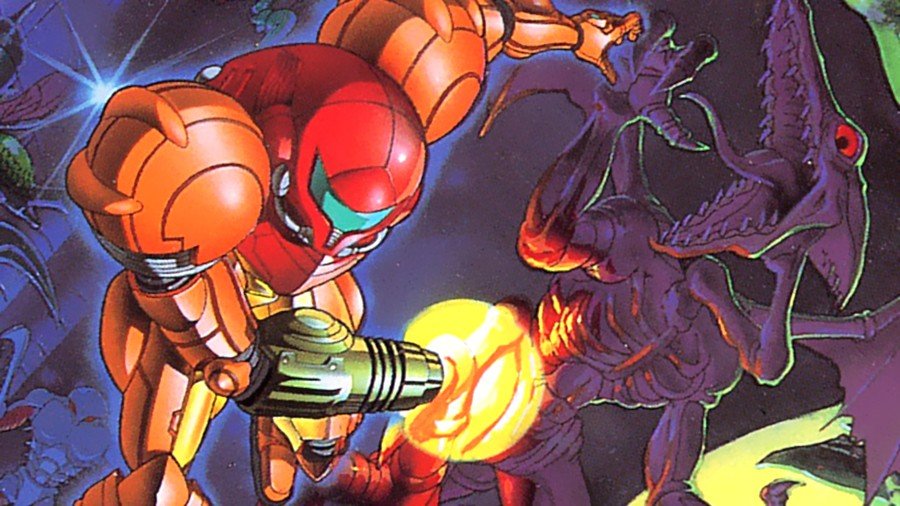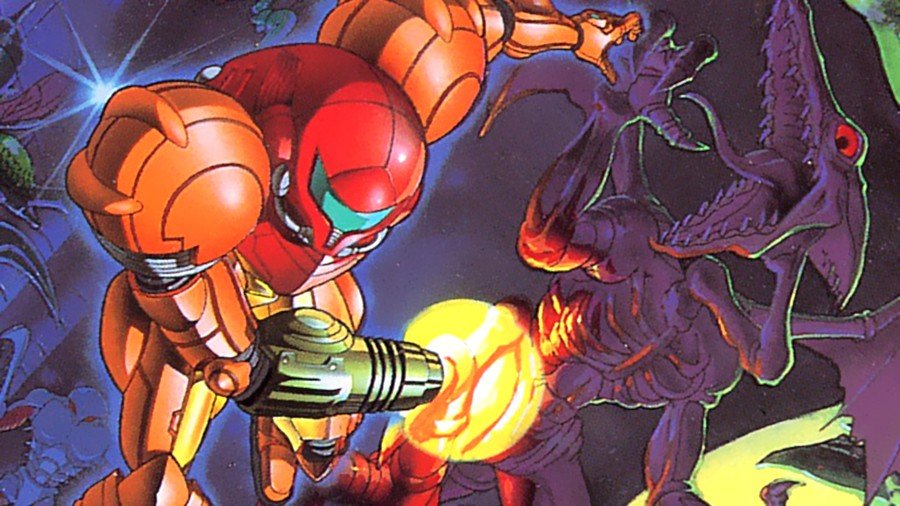

My first experience with the Metroid series was relatively unremarkable: I just bought Super Metroid for my SNES, back when a brand new SNES game was something you could just walk into a local shop and buy.
I took its oversized box home, flipped through the glossy Player’s Guide, and noticed something odd — Samus Aran, the protagonist shown on the front cover wearing a thick red and yellow armoured suit shooting at the angry monster with a head full of teeth, was described as a “she”. And it wasn’t a one-off typo either — “she” “her” and “heroine” cropped up constantly throughout the guide’s seventy-ish pages, as if the character exploring this harsh planet and performing all of the cool actions in the illustrations really was a girl.
I checked the artwork again — thick armour, no pyramid-shaped chestplate or cleavage window. She wasn't just carrying a gun but her entire right arm was enveloped in a cannon, apparently off on a serious sci-fi horror adventure all by herself…
I was shocked. Samus Aran was a girl? Really?
No, not quite — Samus Aran was a woman.
This revelation would have hit me around the head in the summer of 1994 at the very earliest, which would have meant I was at the time an enthusiastic almost-teen girl trying to find where I belonged in a hobby that had no problem basing mainstream advertising campaigns around masturbatory innuendo, exclusionary language, and to not put too fine a point on it, great big boobies. Games were by guys for guys, and I could either stay and accept that immutable fact or go back to whatever it was girls my age were supposed to like (I still have no idea what girls are supposed to like — I think I missed that particular memo).
At this time I had to learn to be begrudgingly grateful for the likes of Chun Li and Blaze Fielding — and what was I complaining about anyway? They could both fight and neither wore a pink dress, so what more did I want?
At this time I had to learn to be begrudgingly grateful for the likes of Street Fighter II’s Chun Li and Streets of Rage’s Blaze Fielding; both characters cut from the same "fast-but-weak” cloth, both featuring “bonus” panty shots as part of their standard animation routines, both designed as something of a secondary choice in the games they were created for. It was that or nothing — and what was I complaining about anyway? They could both fight and neither wore a pink dress, so what more did I want?
There are various ways of expressing what I wanted: “Representation” and “Equality” are both handy grown-up ways of framing it, but what it really boils down to is the simplest most complicated thing around — I wanted games to be fair. I wanted to not have to make do with the only choice on offer, or to tell myself the character I’d been lumbered with was wearing the bare minimum amount of clothing possible because 'she wanted to' and that I was prudish to question whether a leather thong was standard ninja outerwear.
I wanted Samus; a solo-flying, gun-toting, bounty hunter from the future who thought nothing of spin-jumping through lava, shooting alien space pirates in the face, and considered escaping a space station filled with dead bodies just before it explodes nothing more than an attention-grabbing opener — a prelude to the real adventure.
And that’s why Samus shocked me. Because she was fair.
There may not be a lot of common ground between someone who blasts huge alien brains for a living and a young girl living in the UK, and as characters go she’s so covered up and so silent, there was barely anything to her beyond the brief snippets of backstory mentioned in the guide, but through her I could see a future for myself, for women, in a hobby I loved so very much. She was an alternative made real, and not in the thin technicality of an optional bikini-clad “warrior” portrait in a create-your-own-adventurer first-person RPG, but on the front of a SNES game by one of the biggest developer-publishers in the business.
Samus proved people like me could be something other than a castle’s princess, a hero’s prize, or a pubescent boy’s pin-up fantasy
Samus proved people like me could be something other than a castle’s princess, a hero’s prize, or a pubescent boy’s pin-up fantasy — people like me could stomp through the rain of an alien world, could have the life-force sucked out of us by strange organisms in hostile environments, could navigate through hidden vents, or run so fast enemies popped when we touched them and soft walls crumbled before our unstoppable might.
But there was more to it than being the polar opposite of fast-but-weak: Samus wasn’t out there being an in-your-face “Grrl” either; she wasn’t the embodiment of the “Girl Power” movement that began making waves in the mid-'90s, and she neither wannabe’d my lover or for me to get with her friends — she just quietly was. She was proof just existing and doing what she did best — blowing things up with missiles and fighting Ridley to the death (again) — could be enough of a reason for her to be a woman; without any excuses, explanations, or as a reluctant alternative to a “real” hero, and I took that to heart. If it was OK for Samus to be here and be her uncompromised self, then maybe it was OK for me, too.
There are of course legitimate criticisms to be levelled at Metroid, Samus, and Nintendo’s ongoing treatment of the series and its star. The player’s reward for doing well in many classic Metroid games is often to see Samus in increasing states of undress, which feels completely at odds with the self-sufficient Chozo-raised hunter for hire character they’ve just cleared the game as, and her current characterisation veers wildly between “I will wipe out the most dangerous threat to the galaxy by myself” and “I’ll do whatever Adam orders me to under any circumstances”.
We'll have to wait and see how she's portrayed in the upcoming Metroid Dread, but on balance the series has got more right than it has wrong, and Samus herself still feels like nothing less than hope to people like me; a heroine not only in her own world but in ours, too.
